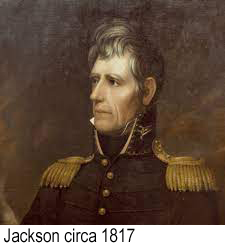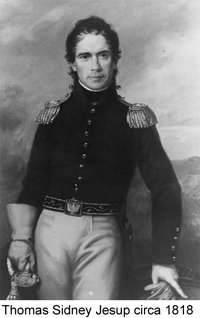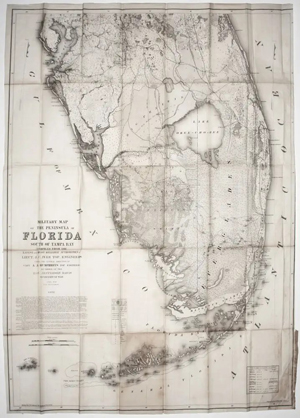
The President’s Message:
The Round Table will not be meeting in July
or August. I look forward to
seeing everyone in the fall. If
you have a program you would like to give, please call me at
561/967-8911. We are scheduling
presentations for the coming months and look forward to a return
engagement by Patrick Falci and Robert Macomber.
Gerridine LaRovere
July 12, 2023 Program:
There will be no July meeting.
June 14, 2023 Program:
Guy
Bachman has worked with the Florida Architectural Society, Florida
Anthropological Society, and was President of the Loxahatchee
Battlefield Preservation. He
was a member of our organization way “back in the day.”
His topic is “Members of the military who served during the
Seminole Wars in Florida who later rose to fame during the Civil War.”
The
presentation has been divided up into five parts.
They are the time period leading up to the Seminole Wars, the 3
wars, and the coming American Civil War.
Guy began his talk by noting that our group has gotten a lot
smaller today than it was when he was an active member.
All history focused groups are feeling the pinch of downsizing.
This is because history is not being taught in our schools.
By way of an introduction, it was mentioned that many of the
leaders in the Civil War “got their feet wet” as lieutenants in the
Seminole Wars. This was
quite literal as those wars were fought in the swamps of Florida.
Imagine what Florida was like in the 1830s.
Where we are there were no cities.
You had to go down to Key West before you would run into citizens
of the United States. It was
the biggest city in Florida for 90 years.
In 1850 it was the richest city in America on a per capita basis.
And how did it come into all of this wealth?
It was the center of the “wrecking industry.”
You had to go to northern Florida before you would find anything
that could be called a city.
These were settlements such as Tallahassee and Jacksonville.
By the way Jacksonville was named after Andrew Jackson.
Guy mentioned that he often plays the part of the good general in
living history presentations.
 The
first Seminole War began when Florida was actually a Spanish possession.
The year was 1817.
Spain was a waning power at this time.
The Seminole came from the Creek tribe.
Jackson had fought the Creeks in 1814 so he was no stranger to
the people who became the Seminoles.
The Spanish gave them cover as these people acted as a buffer
against invasion by the English speakers.
But the Seminoles raided the southern United States.
This was mainly things like cattle rustling.
They would hit Georgia and then run back to New Spain and hide.
Needless to say, the Georgia
ranchers were not happy and wanted the government to “do something.”
So, General Andrew Jackson led an incursion into the territory
over Spanish objections.
Jackson was an American hero from his action in the War of 1812 and well
known as a successful Indian fighter. The
first Seminole War began when Florida was actually a Spanish possession.
The year was 1817.
Spain was a waning power at this time.
The Seminole came from the Creek tribe.
Jackson had fought the Creeks in 1814 so he was no stranger to
the people who became the Seminoles.
The Spanish gave them cover as these people acted as a buffer
against invasion by the English speakers.
But the Seminoles raided the southern United States.
This was mainly things like cattle rustling.
They would hit Georgia and then run back to New Spain and hide.
Needless to say, the Georgia
ranchers were not happy and wanted the government to “do something.”
So, General Andrew Jackson led an incursion into the territory
over Spanish objections.
Jackson was an American hero from his action in the War of 1812 and well
known as a successful Indian fighter.
It is
important to know that the Seminoles were not one tribe, but a
collection of Indian nations who banded together in Florida.
Among them were the Creeks, Oconee, Alachua, and the Tallahassee.
This led to issues when America would make a treaty with one of
the sub groups the other groups would claim to know nothing about that
treaty. Jackson's forces
destroyed several Seminole towns.
One such incident was known as the Scott massacre.
He proceeds to Pensacola and captures it because the Spanish did
not want a fight. They were
terrified of what they called the “Napoleon of the Woods.”
The major reason for this action was to acquire the territory of
Florida for the United States.
A few years later we did purchase it for five million dollars.
We really got it for free as American settlers in Florida owed
Spain about five million so Florida cost us nothing.
By 1818 the first war was over.
The
second war was longer, 1835 – 1842.
It was the longest and most expensive war in American history.
It cost over thirty million dollars in 1830 dollars.
The Treaty of Moultrie Creek was an agreement signed in 1823
between the government of the United States and the chiefs of several
Seminole groups. It allowed
the Seminoles to stay in Florida for 20 more years.
However, Jackson became president in 1829.
He did not honor any treaties with any Indian tribe.
In 1835 Jackson sent Major Francis Langhorne Dade down Fort King
Road, the first highway in the state, to try and quell the Seminoles.
The Indians did not like the fact that the treaty was not being
honored. Dade had 105 men
when he was ambushed in what became known as the Dade Massacre.
As Dade was nearing his
destination his party was ambushed by 180 warriors led by Micanopy.
One of the first shot killed Dade who was an obvious target
riding a horse. At about the
same time the famous Indian, Osceola, killed the Indian agent, Wiley
Thompson who had once arrested him and put him in cuffs.
Thompson and all of his associates in Fort King were killed.
Of
Dade’s men about 50 survived the initial attack, retreated, and built a
make shift fortification made of logs which Guy called a pig pen.
That fort is still there today.
The Indians were about to leave when one of them named Jumper
said no. He said “we have
done well, but now we have them in a pig pen.”
Only three survived the slaughter.
As time went on many forts were constructed.
They were given names to commemorate those who were in the
massacre. Many of the
Seminoles who fought were black, and they were called Black Seminoles.
They still were slaves to the Seminoles, but they felt they got a
better deal from the Indians.
Later on, some became leaders and even chiefs, like Abraham.
There
were other massacres in the early days of the 2nd War.
Guy described one that occurred on the New River involving a
wrecker and mill owner named William Cooley.
He sold a kind of flour to the Seminoles from his mill.
One day, when he was out wrecking, the Indians came to his home
and killed his wife and baby.
There were many such incidents all over the state.
Most of these favored the Seminoles.
The Americans went through seven generals in seven years trying
to find what strategy and tactics would work.
It was very rough to combat the hit ‘n run approach used by the
Seminoles.
Winfield Scott was here for a while where he tried Napoleonic tactics
without success. Eventually they got General Thomas Sidney Jesup who was sent to Florida to take
command of the campaign in 1836.
Instead of futilely pursuing parties of Seminole fighters through
the territory as previous commanders had done, Jesup changed tactics and
engaged in finding, capturing or destroying Seminole homes, livestock,
farms, and related supplies, thus starving them out.
they got General Thomas Sidney Jesup who was sent to Florida to take
command of the campaign in 1836.
Instead of futilely pursuing parties of Seminole fighters through
the territory as previous commanders had done, Jesup changed tactics and
engaged in finding, capturing or destroying Seminole homes, livestock,
farms, and related supplies, thus starving them out.
About
the same time a famous escape happened at Fort Marion in St. Augustine.
There was a famous Indian leader held prisoner at the fort known
as Wild Cat. He lost some
weight, pulled out a bar, jumped 30 feet, and made good his escape with
several others. Osceola, who
was quite old and also a prisoner, was too weak to escape.
Osceola remained confined there until he was moved to Fort
Moultrie near Charleston, SC where he died.
The doctor who performed the autopsy cut off his head which made
its way up to a museum in New York.
The
most famous battle of the War was the Battle of Okeechobee on Christmas
Day, 1837, under the command of Colonel Zachary Taylor.
Taylor commanded about 1,000 Missouri volunteers and federal
troops. They faced 400
Seminoles who knew the soldiers were coming.
The Indians sent a warrior to talk to Taylor.
The American were led to the lake shore where the Seminoles were
hidden in the sawgrass. They
wanted Taylor to perform a frontal assault which he did.
The American suffered tremendous losses, but they pushed the
Indians into the lake. Yet,
even then some of the warriors escaped.
Taylor became famous from the Battle of Okeechobee.
But
the biggest battle of the war was just about to happen.
The soldiers pursued the Seminoles to the Loxahatchee River.
The Indians were outnumbered 1,600 to 200 – 300.
The story was not so much about the battle, but the American
Joseph E. Johnston. He was
21 years old and was attached to a small naval force as a topographical
engineer. It was the first
encounter known as Powell’s Battle.
Powell was a navy officer with 100 men.
He spots a smoke signal and follows it into the woods.
It was a trap. 300
Indians shoot all of the officers with one blast.
The Seminoles had rifles, but Powell’s sailors had only muskets.
However, while the rifles were very accurate at long range the
ball was very small so often the target was only wounded.
Johnston was shot seven times, but he was wearing a frock coat so
he was only slightly injured.
He led a rear-guard action.
He maintained good control of the men who performed a retreat
under fire. Johnston had
small groups of men stop and return fire so his small band made good
their escape. Guy told the
story of a black sailor who carried the wounded Lt. Fowler back to
safety.
The next story was a 200-mile march through the
swamp. The officer who led
this march was Lt. Robert Anderson who will become famous at Ft.
Sumpter. His role during the
Seminole Wars was to build roads and bridges under the most trying
conditions of tropical Florida.
Military Trail is one such road.
Biting insects was a problem.
One technique they employed was to rub themself with cow dung at
night. The heat, insects,
and tropical diseases led the soldiers to die sometimes by their own
hand as suicide.
Our story briefly touched on the story of Major
William Lauderdale and his interaction with Jesup, the commander.
The major was leading the Tennessee Volunteers who thought they
were being badly treated by the regular army.
At one point in the battle the boys from Tennessee were ordered
by Jesup to cross the river to attack.
Lauderdale balked and Jesup threatened to shoot the major.
But thinking better of the idea, that this action might not sit
too well with Andrew Jackson, Jesup to the lead and headed the
volunteers across the river.
As the war moves on Jesup is getting sick and tired
of the fight. He decides on
his own to make peace. Now
he is not political, he is an Army officer.
But he takes things into his own hands and makes a deal at a
place called Camp Truce near today’s Boynton Beach.
He makes an agreement and then writes the President who turns the
letter over to Secretary of War Joel Roberts Poinsett.
Poinsett rejects the deal.
Jesup is told he must remove the Indians to Arkansaw or
annihilate them. Nothing was
settled, there was no movement by anyone, and the war dragged on for
four more years.
Finally, in 1842, Tyler becomes President.
He is a Whig and they were always against this war.
The war had always been unpopular.
The Third Seminal War (1855–1858) was not a very big deal.
Some Seminoles did some raids on the growing settler villages.
However, the Indians were sick of the war too.
When some white settlers were killed, the Indian leader, Sam
Jones, said he would find out who did the killing and handle it himself,
which he did. By 1858, most
of the remaining Seminoles were war weary and facing starvation so they
agreed to move into the Big Cypress Swamp.
They never surrendered nor did they sign any peace treaty.
At this point in the presentation Mr. Bachman
presented short clips about people who ended up in the Civil War.
The first noted soldier was Lt. Jubal Early.
He fought in the battle of
Loxahatchee; however, he
was best known for his raid on Washington in the fall of 1864 in the
Civil War. During that operation
Early ran into Lou Wallace, another Seminole War participant, on
Saturday, July 9, 1864, at the Battle of Monocacy.
Although Early with an estimated 15,000 troops defeated Wallace's
troops, the fight forced Early to retire to Baltimore.
The effort cost Early a chance to
capture Washington, D.C.
Adding to the cast of Seminole Wars characters was Braxton Bragg.
He was involved in the Battle of Nashville, among other
engagements, but he was not known as a great general.
They named a fort after him, but they are in the process of
renaming it from Fort Bragg to Fort Liberty.
Stephen Mallory was a famous politician and judge from Key West.
He fought in the 2nd Seminal War.
He ended up as the Confederate Secretary of the Navy.
Another young lieutenant was George Thomas.
He started in Florida and gain considerable fame as the “Rock of
Chickamauga.” Abner
Doubleday participated in the brief 3rd Seminal War.
Whether he invented baseball is up for debate, but he played a
pivotal role in the early fighting at the Battle of Gettysburg.
In 1858, now captain Doubleday was the last commander of Fort
Capron near St. Lucie.
The list of names was rounded out by Edward Ord,
John C. Pemberton, Samuel P. Heintzelman, A. P. Hill, George G. Meade,
and William T. Sherman. At
the end of the presentation Guy passed around two maps one of which is
shown here.

Last changed: 06/27/23 |

